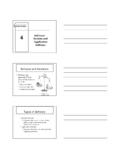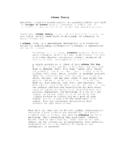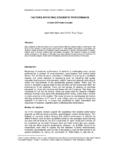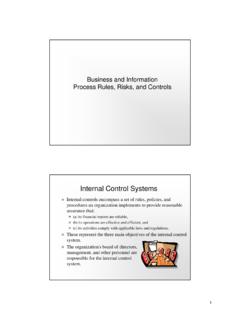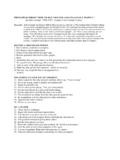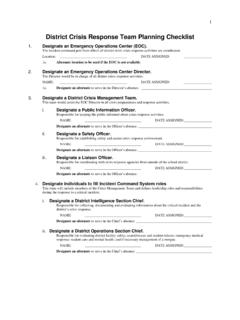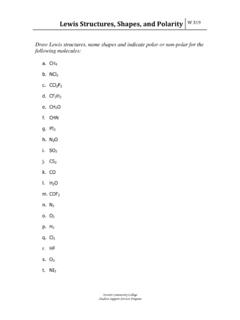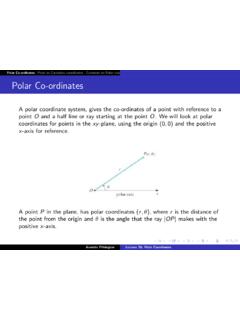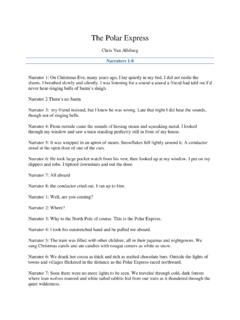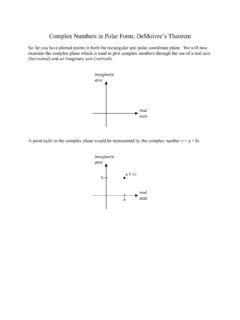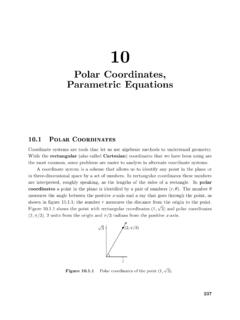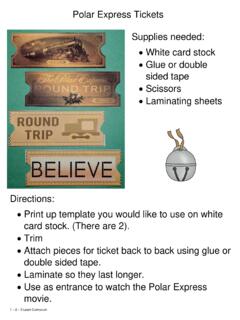Transcription of Polar Covalent Bonds: ElectronegativityPolar Covalent ...
1 Polar Covalent Bonds: ElectronegativityPolar Covalent Bonds: Electronegativity Covalent bonds can have ionic character These are Polar Covalent bonds Bonding electrons attracted more strongly by one atom than by the otheratom than by the other Electron distribution between atoms is not symmetricalBond Polarity and ElectronegativityBond Polarity and ElectronegativitySymmetrical Covalent BondsC CC HPolar Covalent BondsC O + -(non- Polar )( Polar ) Electronegativity (EN):intrinsic ability of an atom to attract the shared electrons in a Covalent bondattract the shared electrons in a Covalent bond Inductive Effect:shifting of sigmabonded electrons in response to nearby electronegative atompygThe Periodic Table and ElectronegativityThe Periodic Table and ElectronegativityC H C - Br and C - I(l)( l)(non- Polar ) ( Polar )Bond Polarity and Inductive EffectBond Polarity and Inductive Effect Nonpolar Covalent Bonds: atoms with similar ENp Polar Covalent Bonds: Difference in EN of atoms < 2 Ionic Bonds: Difference in EN > 2 C H bonds, relatively nonpolar C-O, C-X bonds (moreelectronegative elements) are Polar (moreelectronegative elements) are Polar Bonding electrons shift toward electronegative atom C acquires partial positive charge, +qppg, Electronegative atom acquires partial negative charge, - Inductive effect.
2 Shifting of electrons in a bond in response to EN of nearby atomsElectrostatic Potential MapsElectrostatic Potential Maps Electrostatic potential pmapsshow calculated charge distributions Colors indicate electron-rich (red) and electron-(bl)ipoor (blue) regions Arrows indicate direction of bond polarityof bond polarityPolar Covalent Bonds: Net Dipole Moments Molecules as a whole are often Polar from vector summation of individual bond polarities and lonepair contributionsindividual bond polarities and lone-pair contributions Strongly Polar substances soluble in Polar solvents like water; nonpolar substances are insoluble in water. Dipole moment ( )-Net molecular polarity due to difference in Dipole moment ( ) -Net molecular polarity, due to difference in summed charges - magnitude of charge Qat end of molecular dipole times distance rbetween charges = Q r, in debyes(D), 1 D = 10 30 coulomb meter length of an average Covalent bond, the dipole moment would be 10 29 C m, or of Net Dipole MomentsAbsence of Net Dipole Moments In symmetrical molecules, the dipole moments of y,peach bond has one in the opposite direction The effects of the local dipoles cancel each otherDrawing Lewis StructuresDrawing Lewis Structures Draw molecular skeleton:this will come with practice, remember atom valence Determine number of available valence electrons:add an electron for each negative charge, remove an electron for each positive charge Draw all single Covalent bonds and lone pairs.
3 Give as many atoms as possible full octets, assigning lone pairs to most electronegative atoms Convert lone pairs to multiple bonds if needed:to satisfy octet rule for as many atoms as possible Assign formal charges to all atoms:the sum of all charges must equal total charge of the moleculeExample: Nitromethane: CH3NO2 Example: Nitromethane: CH3NO2 HOHHCNOV alence E = 3(1) + 1(4) + 1(5) + 2(6) = 24 e-Step 1&2H H HHHCNOO Step 3&4 HHHCNOO H H Step ChargesFormal Charges Sometimes it is necessary to have structures with formal chargesidiid l ton individual atoms We compare the bonding of the atom in the molecule to the valence electron structure If the atom has one more electron in the molecule, it is shown with a - charge If the atom has one less electron, it is shown with a + charge Neutral molecules with both a + and a - are dipolar Atomic sulfur has 6 valence electrons.
4 Dimethyl suloxide sulfur has only 5. It has lost an electron and has positive charge. Oxygen atom in DMSO has gained electron and hashas gained electron and has (-) Formal ChargesCommon Formal Chargescharges are typically shown (not necessarily the lone pairs)charges are typically shown (not necessarily the lone pairs)add necessary lone pairs and charges to the following compounds:ResonanceResonance Some molecules have structures that cannot be shown with a ilisingle representation In these cases we draw structures that contribute to the final structure but which differ in the position of the bond(s) or lone pair(s)pair(s) Such a structure is delocalized and is represented by resonance forms The resonance forms are connected by adouble-headedarrow The resonance forms are connected by a double-headedarrowWe say the pi bond is delocalized, and valence bond theory cannot describe where Pi bond and one lone pair are located.
5 This is why we must draw multiple versionsAnd use molecular orbital theory to show delocalizationCurved Arrows and Resonance FormsCurved Arrows and Resonance Forms We can imagine that electrons move in pairs to gpconvert from one resonance form to another A curved arrow shows that a pair of electrons moves fromthe atom or bond at the tail of the arrowtothefromthe atom or bond at the tail of the arrow tothe atom or bond at the head of the arrowDrawing Resonance FormsDrawing Resonance Forms Redraw all atoms and sigma bonds in same positiongp Only move pi electrons and lone pair electrons (note that electrons must remain with same atom) using curved arrows to illustratecurved arrows to illustrate All resonance forms must have same net charge Never violate the octet rule for 2ndrow atoms Resonance forms may be equivalent (degenerate) but do not have to be Not all resonance forms contribute equally to theNot all resonance forms contribute equally to the overall resonance hybrid There are two additional resonance structures for nitromethane can you draw them?
6 ??nitromethane, can you draw them???Guidelines to determine major resonance ibcontributor 1. Structures with maximum octets are preferredCOCO minormajorNONO minormajor 2. Charges should be located on atoms with compatible electronegativitymajorminorCNNHHCNNHH 3. Structures with minimum charge separation are preferredmajorminorHHOO majorminorHCOOHHCOOHR esonance HybridsResonance Hybrids A structure with resonance forms does not alternate between hf(idiid lfii)the forms (individual resonance forms are imaginary) Instead, it is a hybridof all resonance forms, so the structure is called a resonance hybrid Flb(CH)h tfith For example, benzene (C6H6) has two resonance forms with alternating double and single bonds In the resonance hybrid, the actual structure, all its C-C bonds equivalent midway between double and singlebonds equivalent, midway between double and singleDifferent Atoms in Resonance FormsDifferent Atoms in Resonance FormsOO - - Are any resonance structures degenerate?
7 What is major resonance contributor? - What is major resonance contributor? Can you draw any more resonance structures?Formal Charge ProblemsFormal Charge ProblemsProvide formal charges for all heteroatoms (non carbon atoms)HHNP rovide formal charges for all heteroatoms (non carbon atoms).Remember, all H's on heteroatoms must be (and are) drawn in to determine number of valenceelectrons to know how many lone pairsFor each compound below, provide all lone pairs and hydrogens required tobe consistent with the given formal charges (again hydrogens are provided onto addOOHheteroatoms along with any necessary charges).OOResonance/Skeletal ProblemsResonance/Skeletal ProblemsOOOONNNHR esonance Practice Problems1. Draw the important resonance structures for each of the following in answer keys to the previous slidesPut in answer keys to the previous slidesalso put in slide about hydridization in resonance forms like pyrroleif sp3 in one, sp2 in another must have sp2 hybrid for p orbital and not moveyother atomsBr nsted Acids and BasesBr nsted Acids and Bases ABr nsted acidis a substance that donates A Br nsted acidis a substance that donates a hydrogen ion (H+) A Br nsted baseis a substance that accepts pthe H+Acids are shown in red, bases in blue.
8 Curved arrows go from bases to acidsK the Acidity ConstantKathe Acidity Constant The concentration of water as a solvent does not change significantly when it is protonatedsignificantly when it is protonated The molecular weight of H2O is 18 and one liter weighs 1000 grams, so the concentration is ~ M at 25 The acidity constant,Kafor HA Ketimes M (leaving y,ae(g[water] out of the expression) Karanges from 1015 for the strongest acids to very small values (10-60) for the weakestpK the Acid Strength ScalepKathe Acid Strength Scale pKa= -log Kapaga The free energy in an equilibrium is related to log of Keq( G = -RT log Keq) A smaller value of pKindicates a stronger acid and A smaller value of pKaindicates a stronger acid and is proportional to the energy difference between products and reactantsThKfti1574 The pKaof water is in Acidity: What makes a strong idacid?)
9 1 StthfthHAb d1. Strength of the H-A bondThe stronger this bond is, the less likely it will break to give-up an H+. For strong acids, this is a relatively weak bond. Important factor whencomparing bonds between hydrogen and atoms within the same columnpgyg(not row) of the periodic tableWhy is HI a weaker bond than the others?HI>HBr>HCl>HFH-I > H-Br > H-Cl > H-FpKa = -10 -9 -7 in Acidity: What makes a strong idacid?2 Stability of Conjugate Base A-2. Stability of Conjugate Base, AIf the resulting anion from the dissociation is stabilized (A-), it will be easier to form resulting in a stronger acid. Two major influences operate here:A: Effect of Electronegativities. If the hydrogen is connected to a very electronegative atom the bond is polarized and the eventual breaking of the bond to form A-, a stable anion since A is very electronegative, will become easier and result in a stronger acid (unless you are comparing atoms in theeasier and result in a stronger acid (unless you are comparing atoms in the same column of the periodic table as in the above example where you must consider bond strength).)
10 HFHOHHNHHCHH-F > H-OH > H-NH2> H-CH3pKa = 38 49 Trends in Acidity: What makes a strong idacid?B: Resonance Effects Delocalization of charge (through resonanceB: Resonance Effects. Delocalization of charge (through resonance showing the negative charge is located on more than one atom) will stabilize the anion, making it easier to form and result in a stronger = 5H3 COHH3 COpKa = 16H2O versus HNO3 Trends in Acidity: What makes a strong idacid?3 Inductive Effects3. Inductive EffectsElectronegative groups can inductively pull electron density towards themselves. This can result in a net stabilization of the conjugate base, A-. This effect is much weaker than that of resonance noted above. An inductive effect rapidly decreases with >CH2FO-H>CH2 FCH2O-HCF3OH > CH2 FOH > CH2 FCH2 OHpKa = 10 12 13 Some Common Organic Acids and their pKa sFunctional Group approx pKaFunctional Group approx pKa4936pKa Table.)


